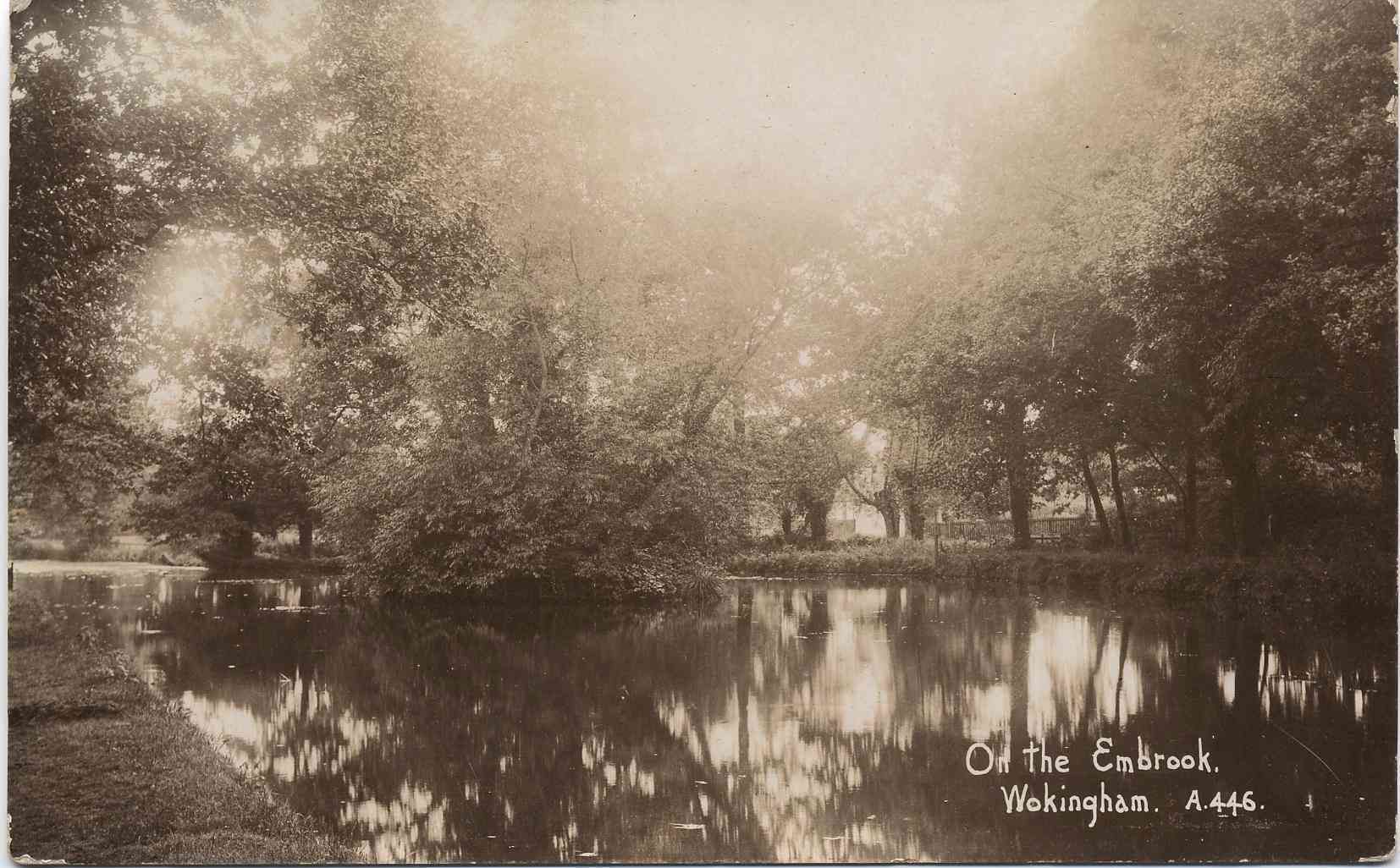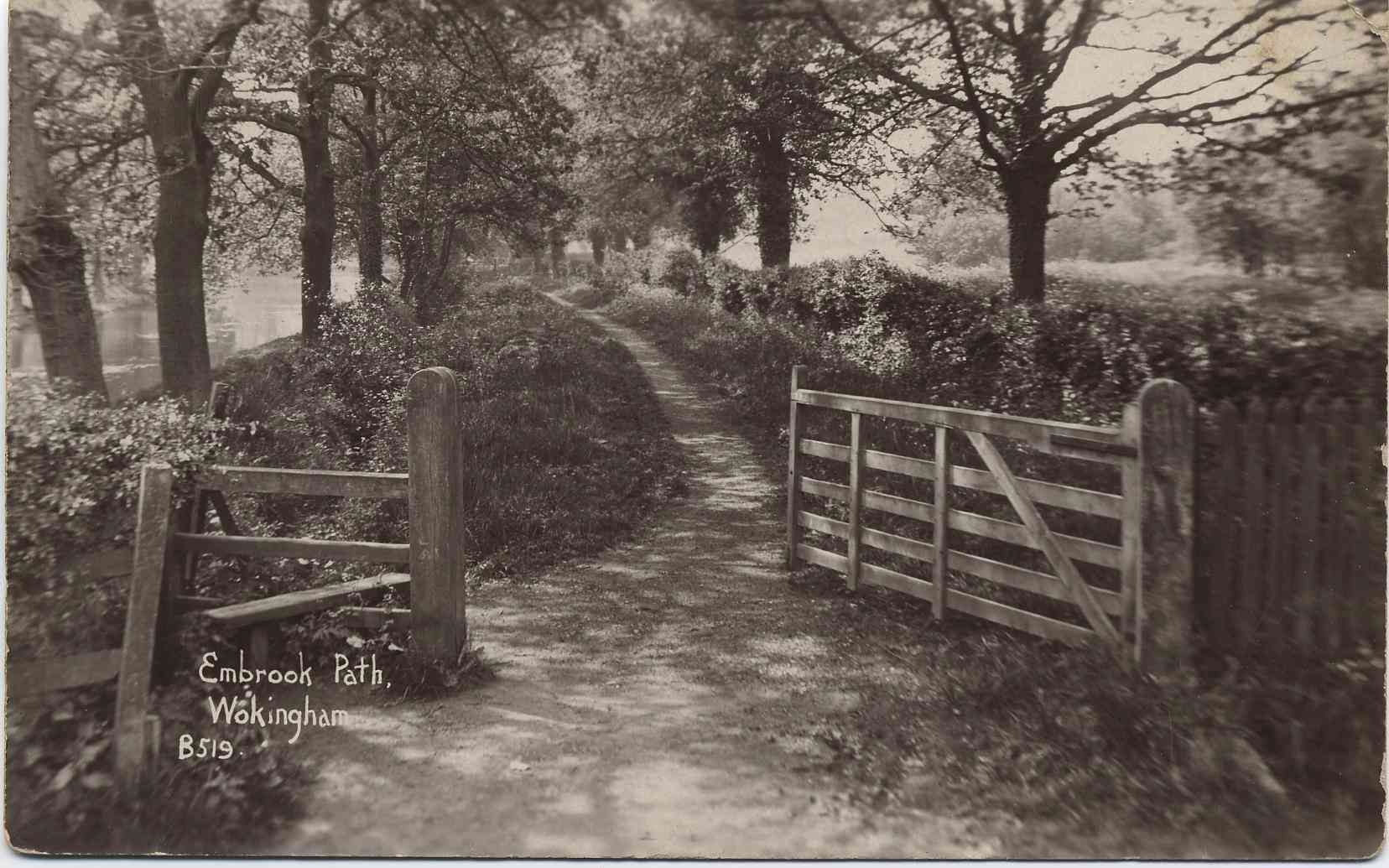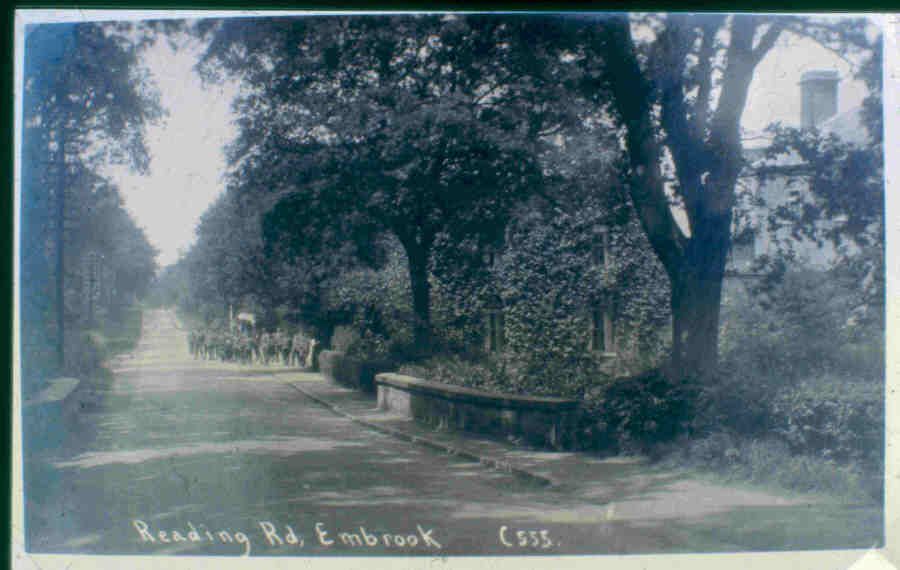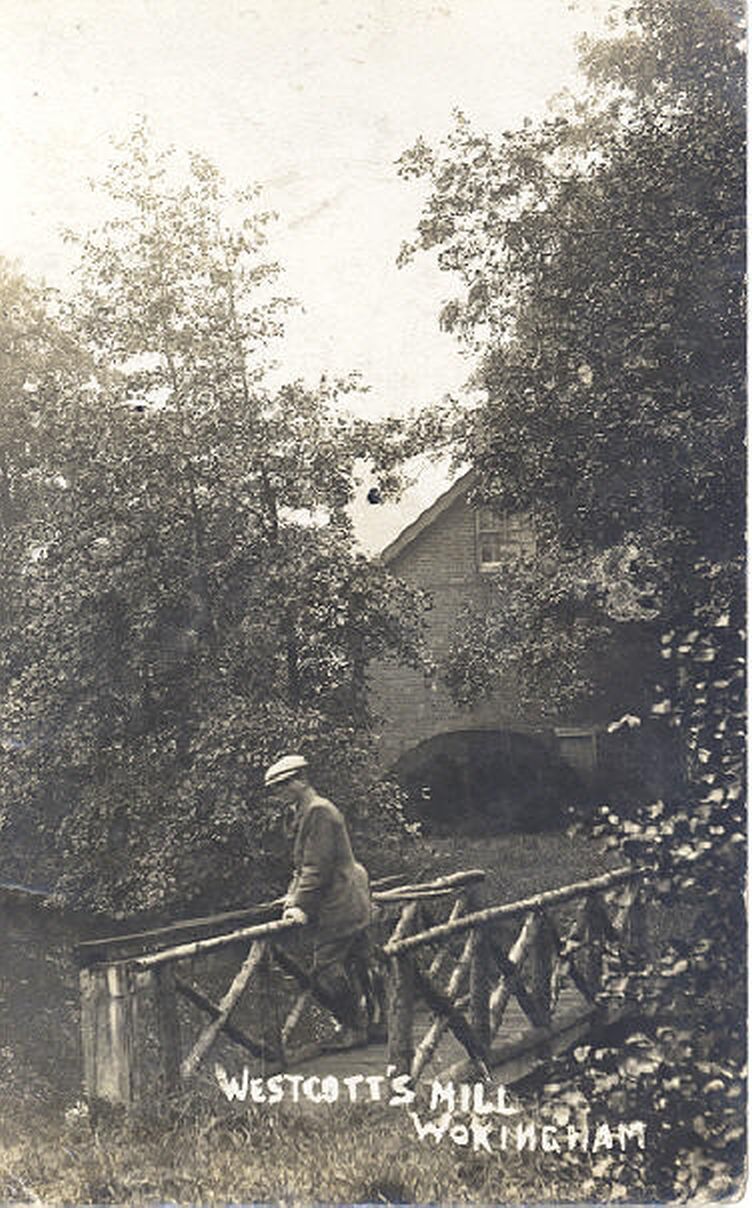
Emmbrook Mill
 the mill leat (body of water
that fed the water wheel) used to continue on from the weir running due north
from this point until it reached the Reading Road. This feature was a very
large expanse of water up to about 50 feet wide. At the southern end it was
wide enough for an island to be shown on the Ordnance Survey map and the
postcard on the left. The water collected in the leat would have been stored
to power the water wheel, but it is unclear from the maps as to where the
narrowing took place for the mill race. I can only presume that this was just
south of the Reading Road and that the wheel was fed from a very fast
flowing, but narrow, channel flowing under Reading Road. After powering the
water wheel the channel rejoined the main Emm Brook river at the railway
embankment.
The
mill leat does not exist now in any meaningful form. However, a small trace
of it is still visible adjacent to the entrance to 128 Reading Road.
the mill leat (body of water
that fed the water wheel) used to continue on from the weir running due north
from this point until it reached the Reading Road. This feature was a very
large expanse of water up to about 50 feet wide. At the southern end it was
wide enough for an island to be shown on the Ordnance Survey map and the
postcard on the left. The water collected in the leat would have been stored
to power the water wheel, but it is unclear from the maps as to where the
narrowing took place for the mill race. I can only presume that this was just
south of the Reading Road and that the wheel was fed from a very fast
flowing, but narrow, channel flowing under Reading Road. After powering the
water wheel the channel rejoined the main Emm Brook river at the railway
embankment.
The
mill leat does not exist now in any meaningful form. However, a small trace
of it is still visible adjacent to the entrance to 128 Reading Road.
 If you
enter the gate to the long drive down to the house there is woodland to your
left. Carefully entering this land, it drops away very suddenly and this is
the bank of the old mill leat. The postcard on the right shows the same
gateway and the mill leat. Flows have been altered in recent years so that
this channel provides drainage of some sort from parts of the Woosehill area
with the water rejoining the small section of the Emm Brook that lies to the
west of the Spine Road. The channel was created as part of the development of
the Woosehill Spine Road when the Woosehill development was being built.
The likely original course of
the river and the adaptations to feed the mill have been derived from the
1:2500 maps in Wokingham library and the 1883 map that can be seen online on
the “Old Maps” web site
The Wescott family are
described as Paper Manufacturers from 1871 to 1891. But in 1901 the
description is just Miller. So were they still making paper at Embrook Mill
or had they reverted to corn milling as suggested by later maps? The library in Wokingham has a
document “Berkshire Old & New” from the Berkshire Local History
Association volume 21 in 2004 that states
If you
enter the gate to the long drive down to the house there is woodland to your
left. Carefully entering this land, it drops away very suddenly and this is
the bank of the old mill leat. The postcard on the right shows the same
gateway and the mill leat. Flows have been altered in recent years so that
this channel provides drainage of some sort from parts of the Woosehill area
with the water rejoining the small section of the Emm Brook that lies to the
west of the Spine Road. The channel was created as part of the development of
the Woosehill Spine Road when the Woosehill development was being built.
The likely original course of
the river and the adaptations to feed the mill have been derived from the
1:2500 maps in Wokingham library and the 1883 map that can be seen online on
the “Old Maps” web site
The Wescott family are
described as Paper Manufacturers from 1871 to 1891. But in 1901 the
description is just Miller. So were they still making paper at Embrook Mill
or had they reverted to corn milling as suggested by later maps? The library in Wokingham has a
document “Berkshire Old & New” from the Berkshire Local History
Association volume 21 in 2004 that states
Wokingham- Emmbrook Mill
The Wescott family started this manufactory around 1868. It continued in listings until at least 1891, but it is not found from 1895 onwards. The Ordnance Survey map of 1883 shows the paper mill situated between Emmbrook House and Emmbrook Farm. In 1903 a Paper Bag Manufactory under the ownership of Wm Wescott was listed at Emmbrook; however it was no longer listed under 'Paper Manufacturers' in directories. This document is certainly incorrect in respect of the start date for the mill, as it is shown on the 1841 census. Note that in 1851 there is no entry between The Holt and the Horse and Groom public house – the Horse and Groom was the predecessor of the Rifle Volunteer. Presumably the Wescott’s purchased the mill in 1868 from Robert Dixon. In 1871 Robert Dixon is running a mill in Finchampstead. The Wescott family who operated the mill from at least 1871 were the siblings of Thomas Manley Wescott who became the first Mayor of Wokingham in 1885. Thomas is first shown in Wokingham in 1861, living in Peach Street. The whole Westcott family (note the more recent loss of the middle “t” in the name) are shown on the 1841 census living in Bristol. Only John was born in Bristol, the others were from Devon. To date only the baptism of Thomas Manley Westcott has been traced, in Bradninch (south of Tiverton). Their father, Thomas Westcott, is described as “of Kentisbeare” when he married Mary Ann Manley in 1829. Ultimately the mill passed to Charlotte Wescott who was described as a niece on the 1901 census. But so far her connection to the family has not been totally established. In 1916 Charlotte married Frank Heelas from the family who ran the department store in Wokingham town centre. She was described as the daughter of Henry Thomas Wescott (deceased). The 1851 census shows the Wescott family as paper makers in Romsey, Hampshire and there is a son Henry, aged 9. If Charlotte was a niece of the Wescott brothers, then she was almost certainly the daughter of this Henry. However, he and Charlotte have not been confirmed on later censuses. Peter Joslin, an avid collector of postcards, kindly provided copies of the two pictures of the mill leat. Other knowledge about the mill has been provided by Colin Mitchell, Barbara Young, Ken Goatley, Richard Dadd and by searches of censuses and births, marriages and deaths.and the 1851 census transcription by Berkshire Family History Society. Since presenting the findings of this investigation at a public meeting, two additional photographs of the mill have been provided by Brian Eighteen. These are early 20th century postcards and depict Reading Road, including the Rifle Volunteer and the mill buildings – note the soldiers outside the pub.The tabs on the navigation bar above give a history of one of the owners of Emmbrook Mill the Wescott's and includes their family history and family tree
 Frank Charles Heelas was the fourth son of Tyndale and Amelia. Heelas In 1904 he acquired the flour mill in Reading Road, near Woosehill Roundabout, from John Wescott. At the time of purchase the mill was only two years old the previous one having been destroyed by fire.
Frank Charles Heelas was the fourth son of Tyndale and Amelia. Heelas In 1904 he acquired the flour mill in Reading Road, near Woosehill Roundabout, from John Wescott. At the time of purchase the mill was only two years old the previous one having been destroyed by fire.
 Frank changed the course of the Emm Brook and created a mill run to contain deeper water for the mill and worked it until about 1962.
In 1916 he married Charlotte Mary Elizabeth Wescott (1875-1961) a niece of Thomas Manley Wescott former mayor of Wokingham. There were no children. They resided at Mill House that was renown for its well tended gardens.
Frank and Charlotte were both public spirited and generous making numerous donations to Emmbrook Mission Room and to St Pauls Church. They also participated in various local events.
Charlotte died in 1961 and shortly afterwards, Frank moved to Fernleigh at No 19 The Terrace, Wokingham. He died 3 years later on the 19th of September 1964. His funeral service was held at St Pauls Church, Wokingham after which he, like Charlotte, was cremated.
Part of the mill was taken over by Metalair, a company that manufactured aircraft components for the during the Second World War. The other part became a garage.
During the Second World War Metalair made metal aircraft components for the De Havilland Mosquito., after the war Metalair diversified into other products, including electric clocks, anodised tea trays, children’s tricycles, and the first rotary lawn mower called the Ladybird. After the founder’s death in 1956, the company had to be sold to pay death duties
Later Clifford’s Dairies took over the premises.
Frank changed the course of the Emm Brook and created a mill run to contain deeper water for the mill and worked it until about 1962.
In 1916 he married Charlotte Mary Elizabeth Wescott (1875-1961) a niece of Thomas Manley Wescott former mayor of Wokingham. There were no children. They resided at Mill House that was renown for its well tended gardens.
Frank and Charlotte were both public spirited and generous making numerous donations to Emmbrook Mission Room and to St Pauls Church. They also participated in various local events.
Charlotte died in 1961 and shortly afterwards, Frank moved to Fernleigh at No 19 The Terrace, Wokingham. He died 3 years later on the 19th of September 1964. His funeral service was held at St Pauls Church, Wokingham after which he, like Charlotte, was cremated.
Part of the mill was taken over by Metalair, a company that manufactured aircraft components for the during the Second World War. The other part became a garage.
During the Second World War Metalair made metal aircraft components for the De Havilland Mosquito., after the war Metalair diversified into other products, including electric clocks, anodised tea trays, children’s tricycles, and the first rotary lawn mower called the Ladybird. After the founder’s death in 1956, the company had to be sold to pay death duties
Later Clifford’s Dairies took over the premises.